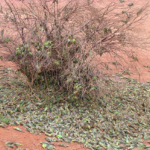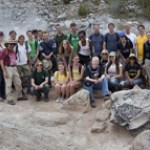Uncategorized
Busy week here, as Eric attempts to wind up his online teaching class, my parents descend for a week of family projects and fair going, and we deal with the daily realities of a rapidly-onrushing fall, complicated (happily) by a long trip and an early Jewish holiday season. So I give you something I wrote way back in 2007.
The other day I thought I'd try out three "fast, easy, healthy, local" recipes that were sent to me from a green website that shall remain nameless because I'm not trying to give them a hard time - I appreciate what they are trying to do.
Why? Because my job now is to…
Today I move to my new home at Big Think
http://bigthink.com/blogs/age-of-engagement
[Follow the blog via its RSS feed, on Twitter, and on Facebook.]
Over the past four years at Scienceblogs, I have had the wonderful opportunity to be part of a blogging network that includes dozens of talented writers and thinkers. Current and former Sciblings such as Deb Blum, Ed Brayton, Benjamin Cohen, Bora, Sheril Kirshenbaum, Jonah Lehrer, Chris Mooney, David Ng, Randy Olson, Chad Orzel, Jessica Palmer, Christina Pikas, Janet Stemwedel, and Carl Zimmer have inspired my writing and introduced me to…
Elvis In 1977 I drove from Nashville down to Memphis with no particular plans regarding Memphis. It was just a place to stop on the way to Hot Springs, Arkansas. I had the name of a cheap motel and a vague idea of where it was. But I kept getting lost. Every time I came to about where this major street was supposed to be, there was a different street there. What the hell was going on?
About the fifth time I came to the right/wrong location, it dawned on me ... "Elvis Presley Boulevard" must have just recently been named as such ...
That, I realized, could also explain another…
I love fishing! I just returned from a weekend fishing trip with my family where we caught these beautiful trout (see photo).
Speaking of fish, I just finished listening to a LifeLines podcast from The American Physiological Society in which Barbara Block from Stanford University discussed her research on bluefin tuna.
Dr. Block uses electronic tags implanted in fish to record information on their location, depth, body temperature, heart rate, food intake, etc. These tags allow her to study the physiology of the animals in their natural environment. Audio clip.
Her research team has tracked…
A typical adult human recognizes that the image one sees in a mirror is oneself. We do not know how much training a mirror-naive adult requires to do this, but we think very little.
When a typical adult macaque (a species of monkey) looks in the mirror, it sees another monkey. Typical adult male macaques stuck in a cage with a mirror will treat the image as a fellow adult male macaque until you take the mirror out of the cage.
(Experiments that attempt to determine if an individual can recognize themselves in the mirror ultimately derive from what is known as the Gallup Test, after Gordon…
Stephen Jay Gould and David Pilbeam wrote a paper in 1974 that was shown ten years later to be so totally wrong in its conclusions that it has fallen into an obscurity not usually linked to either Gould or Pilbeam. However, they were actually right in ways that they could not have anticipated. And even if they were not right, this paper still has much to contribute, including the opening words of that publication in Science, which are very much worthy of consideration for many reasons:
A repost
It is no longer true that there are more practitioners than pieces. In fact, when I…
Photo: Blue crab being monitored for metabolism using a respirometer, courtesy of Louis and Karen Burnett.
Based on information presented at the Global Change and Global Science: Comparative Physiology in a Changing World conference, August 4-7, 2010 in Westminster, Colorado.
Louis Burnett, professor of biology and director of the Grice Marine Laboratory of the College of Charleston and Karen Burnett, research associate professor at Grice Marine Laboratory have been examining the effects of low oxygen and high carbon dioxide levels on the immune system. The results of their research,…
Lucy, Ardi, Frodo, and us: what old bones and new genetics are revealing today.
Who are these people and can we call them family? Listen to Greg Laden and Lynn Fellman discuss how recent fossil and tool discoveries are changing the shape of our family tree.
A report earlier this week showed evidence for stone tool use at 3.39 million years ago -- much earlier than previously thought.
In addition to ancient bones and tools, genetics is filling some of the pre-historic knowledge gaps. For instance, genetic material from 40,000 year old bones show that some of us are one to four percent…
A fairly accurate and well done, and more up to date, account of what has gone on with the Marc Hauser investigation is here, in a piece punished in the New York Times by Nicholas Wade: In Harvard Lab Inquiry, a Raid and a 3-Year Wait.
It is very clear that the Fourth Estate is on the verge of a detailed and clear description of events.
At this point in time, it is probably a good idea for Harvard to release their internal report or a very good summary of it. Here's why:
1) There are people who have worked over the years in Hauser's lab. As long as a cloud of uncertainty rests over this…
Wanted: A shortcut key to zip backwards to the last mispelleded word in a text document. (And, forward too would be nice, but backwards is most important.) Next time you are writing stuff, think about how cool this would be.
See the whole "WANTED" list here.
I will be interviewed on Sunday Morning by Lynn Fellman on Minnesota Atheist Radio. We'll be covering the recent and almost recent news in several areas of human evolution, and discussing "Lucy, Ardi, Frodo, and us: what old bones and new genetics are revealing today"
... but since news from the field comes in so quickly, we may never get to our intended topic, since we can also talk about monkeys and very ancient cut marks on stone tools.
Tune in on Radio 950 KTNF Twin Cities, or catch the Podcast later. I don't think there is a streaming thingie.
Based on information presented at the Global Change and Global Science: Comparative Physiology in a Changing World conference, August 4-7, 2010 in Westminster, Colorado.
Photo:Budgerigars killed by a heat wave on a ranch in western Australia in 2009 courtesy of Blair Wolf.
Blair Wolf, an associate professor of biology at the University of New Mexico, and Andrew McKechnie at the University of Pretoria in South Africa have been studying how desert bird populations might respond to global warming.
According to a press release from The American Physiological Society (www.the-aps.org),
increases…
Excitement in Morris—big thunderstorm just blew through, taking out trees up & down the street, including one that came within inches of annihilating my car. The power is out, & it may be a while before it comes back.
No tornadoes, at least, but the worst part is that it hit while my wife is driving home, and now she's very late…and of course her cell phone is off, and probably buried in that mess in her bag. Grrrr.
She's made it home! And the power just came back, 20 minutes before Futurama! See, Jesus really does love me.
Every summer, the SETI Institute hosts 15-20 college students from around the country as part of its Astrobiology Research Experience for Undergraduates (REU) internship program. The program, which is funded by the National Science Foundation and the NASA Astrobiology Institute, pairs each student with a research mentor at the SETI Institute. At the end of the 10-week internship, each student presents a talk and written report on their research project, and many students go on to present their work at professional conferences during the following academic year.
This year, our 19 REU interns…
The last night of the Comparative Physiology meeting I listened to the neatest lecture on visualizing change in animals given by Dr. Elizabeth Brainerd at Brown University. She provided a wonderful synopsis of imaging techniques throughout history and spoke about using satellites to image large animal migrations all the way down to various microscopy techniques. But what I found most interesting was her description of a contraption called Xâray Reconstruction of Moving Morphology, or XROMM. This new system developed at Brown University allows researchers to view 3 dimensional skeletal images…
I am cribbing significant amounts of this post from a Creative Commons blogpost about tagging the public domain. Attribution is to Diane Peters for the stuff I've incorporated :-)
The big news is that, 18 months since we launched CC0 1.0, our public domain waiver that allows rights holders to place a work as nearly as possible into the public domain, worldwide...it's been a success. CC0 has proven a valuable tool for governments, scientists, data providers, providers of bibliographic data, and many others throughout world. CC0 has been used by the pharmaceutical industry giant GSK as well as…
... which begs a number of different questions that I will think but not say out loud.
This surprising 'result' (which you should not take seriously as stated) comes from a fascinating bit of on -line research and reporting in which Christian Rudder qualitatively tested photographs taken with various technologies and stuff by asking a zillion people "which of the following individuals would you chose for a date" when shown two photographs.
Rudder demonstrates and makes the claim that more complex devices such as digital Single Lens Reflex (SLR) cameras produce more date-worthy photographs…
I just could not wait to write about a seminar that I listened to at the recent Comparative Physiology conference in Westminster, CO. The topic was "paleophysiology". You got it, the study of physiology in extinct animals! Dr. Thomasz Owerkowicz, an Assistant Project Scientist with Dr. James Hicks at UC Irvine, spoke about his research examining alligators to help understand ancient dinosaurs. Many researchers study modern animals in an effort to understand ancient ones, but the caveat is that they often study them in their modern environment. The novelty of this new research is that Drs.…
Today was primary day in Minnesota. Amanda and I are wearing our "I voted" stickers. We wore them to the grocery store. We were the only ones there wearing them. Of course, there were a lot of mullets, and I ain't talking fish, which is like voting with your hair. And, the sound of the country western karaoke rises like the call of the loon above the sound of hail and thunder. Voting with noise. But we voted with a sharpie. The sharpie is mightier than the mullet, though just barely.
Speaking of politics, go visit Uncle Ted is Dead for one of the more moving tributes to Senator Ted…
They both voted against HR 1586, as expected.
I'm voting for Meffert. Right now, as a matter of fact.



